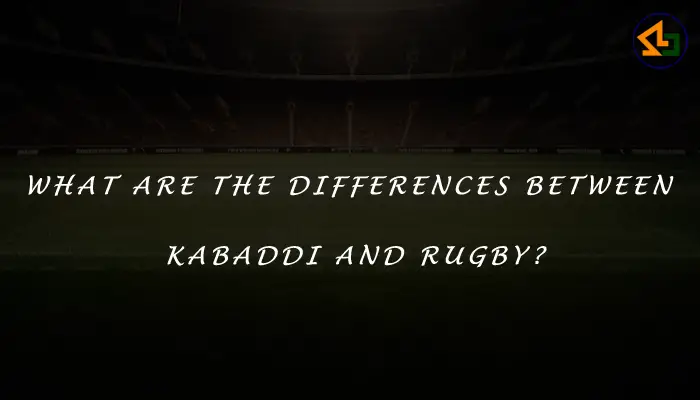Sports have always been a source of entertainment and inspiration for people across the globe. Kabaddi and rugby, though not as universally renowned as football or basketball, hold a special place in the hearts of many. They may not share the same limelight, but they certainly have their own charm and distinct features. Let’s embark on a journey to discover the differences between Kabaddi and rugby and gain a deeper appreciation for both these captivating sports.
Kabaddi: A Traditional Marvel
Origin and History
Kabaddi, often referred to as the “game of the masses,” has its roots deeply embedded in Indian tradition. It dates back thousands of years and has evolved into various forms, such as Sanjeevani Kabaddi and Amar Kabaddi.
Gameplay
One of the key distinctions of Kabaddi is that it is a team sport with seven players on each side. The raider’s role is to enter the opponent’s half, tag as many defenders as possible, and return to their own half, all while chanting “kabaddi, kabaddi.” The defenders must try to stop the raider from returning.
Field and Equipment
Kabaddi is typically played on a rectangular court with clearly defined boundaries. The players wear minimal attire and don’t require any protective gear, making it unique among contact sports.
Rugby: A Test of Strength and Strategy
Origin and History
Rugby, on the other hand, has its origins in England and is believed to have begun in the early 19th century. It was formalized at Rugby School, leading to the creation of rugby football.
Gameplay
Rugby is a full-contact sport played between two teams of 15 players each. The objective is to score points by carrying the oval-shaped ball over the opponent’s goal line or by kicking it through the goalposts. It involves tactics, physicality, and strategy.
Field and Equipment
Rugby is played on a rectangular field with goalposts at each end. Players wear uniforms with padding and helmets to protect themselves from injuries, given the physical nature of the game.
Key Differences
Now that we’ve touched upon the basics of Kabaddi and rugby, let’s delve deeper into the differences that set them apart:
1. Team Size
- Kabaddi: Seven players on each team.
- Rugby: Fifteen players on each team.
2. Contact Levels
- Kabaddi: Minimal physical contact.
- Rugby: High physical contact, with tackling being a fundamental aspect.
3. Scoring
- Kabaddi: Points are scored by tagging opponents and returning safely.
- Rugby: Points are scored by carrying the ball over the opponent’s goal line or kicking it through the goalposts.
4. Protective Gear
- Kabaddi: Minimal protective gear.
- Rugby: Players wear extensive protective gear, including helmets and padding.
5. Field Size
- Kabaddi: Smaller rectangular court.
- Rugby: Larger rectangular field with goalposts.
Frequently Asked Questions
Let’s address some common questions about Kabaddi and rugby:
What are the origins of Kabaddi and rugby?
Kabaddi originated in India, with a rich history spanning thousands of years. Rugby, on the other hand, has its roots in England and emerged in the 19th century.
Which sport is more physically demanding, Kabaddi or rugby?
Rugby is generally considered more physically demanding due to its full-contact nature and the use of protective gear.
Are there any professional leagues for Kabaddi and rugby?
Yes, both Kabaddi and rugby have professional leagues. The Pro Kabaddi League in India and the Rugby World Cup are among the most prominent competitions in their respective sports.
Can women participate in Kabaddi and rugby?
Absolutely! Women actively participate in both Kabaddi and rugby, showcasing their skills and athleticism on the global stage.
Are there any international tournaments for Kabaddi and rugby?
Yes, both sports have international tournaments where teams from different countries compete for glory. The Kabaddi World Cup and the Rugby World Cup are prime examples.
Which sport has a larger global following, Kabaddi or rugby?
Rugby enjoys a larger global following, with a significant presence in countries like New Zealand, England, South Africa, and Australia.
Conclusion
In conclusion, Kabaddi and rugby are two distinct sports that offer unique experiences for players and fans alike. While Kabaddi boasts a rich cultural heritage and minimal physical contact, rugby thrives on its physicality and intricate strategies. Understanding the differences between these two sports allows us to appreciate the diversity that sports bring to our lives. So whether you find yourself chanting “kabaddi” or cheering on a rugby scrum, both sports have something extraordinary to offer.
Thank you for joining us on this journey to explore the differences between Kabaddi and rugby. If you have any more questions or would like to share your thoughts, feel free to reach out!
That’s all! You can also checkout: How did Patna Pirates become so good at kabaddi? and Which is the best team in Kabaddi?







